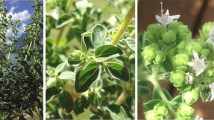Abstract
The leaves of Rosmarinus officinalis harvested from three different locations of Turkey were extracted by both methanolic and supercritical CO2 extraction. Subsequently, six extracts and the active compounds, carnosic acid, and rosmarinic acid were applied to various human cancer cell lines including NCI-H82 (human, small cell lung, carcinoma), DU-145 (human, prostate, carcinoma), Hep-3B (human, black, liver, carcinoma, hepatocellular), K-562 (human chronic myeloid leukemia), MCF-7 (human, breast, adenocarcinoma), PC-3 (human, prostate, adenocarcinoma) and MDA-MB-231 (human, breast, adenocarcinoma) by MTT assay. Supercritical CO2 extracts had superior antiproliferative effect compared to the soxhlet extracts. Although the extracts exhibited various cytotoxic effects against different cell lines, comparatively low IC50 values ranging between 12.50 and 47.55 μg/ml were attained against K-562, being the most sensitive cell line. Moreover, carnosic acid caused the lowest cell viability with values ranging from 13 to 30 % at a concentration of 19 μM after 48 h of treatments, resulting in superior antiproliferative effect. Rosemary extract is a potential candidate to be included in the anti-cancer diet with pre-determined doses avoiding toxicity.


Similar content being viewed by others
References
Thorsen MA, Hildebrandt KS (2003) Quantitative determination of phenolic diterpenes in rosemary extracts: aspects of accurate quantification. J Chromatogr A 995:119–125
Senorans FJ, Ibanez E, Cavero S, Tabera J, Reglero G (2000) Liquid chromatographic-mass spectrometric analysis of supercritical-fluid extracts of rosemary plants. J Chromatogr A 870:491–499
Singletary KW, Rokusek JT (1996) Tissue-specific enhancement of xenobiotic detoxification enzymes in mice by dietary rosemary extract. Plant Foods Hum Nutr 50:47–53
Huang SC, Ho CT, Lin-Shiau SY, Lin JK (2005) Carnosol inhibits the invasion of B16/F10 mouse melanoma cells by suppressing metalloproteinase-9 through down-regulating nuclear factor-kappa B and c-Jun. Biochem Pharmacol 69:221–232
Huang MT, Ho CT, Wang ZY, Ferraro T, Lou YR, Stauber K, Ma W, Georgiadis C, Laskin JD, Conney AH (1994) Inhibition of skin tumorigenesis by rosemary and its constituents carnosol and ursolic acid. Cancer Res 54:701–708
Singletary KW, Nelshoppen JM (1991) Inhibition of 7, 12-dimethylbenz[a]anthracene (DMBA)-induced mammary tumorigenesis and of in vivo formation of mammary DMBA-DNA adducts by rosemary extract. Cancer Lett 60:169–175
Babu US, Wiesenfeld PL, Jenkins MY (1998) Effect of dietary rosemary extract on cell-mediated immunity of young rats. Plant Foods Hum Nutr 53:169–174
Offord EA, Mace K, Ruffieux C, Malnoe A, Pfeifer AMA (1995) Rosemary components inhibit benzo[a]pyrene-induced genotoxicity in human bronchial cells. Carcinogenesis 16:2057–2062
Singletary KW, MacDonald C, Wallig M (1996) Inhibition by rosemary and carnosol of 7, 12-dimethylbenz[a]anthracene (DMBA)-induced rat mammary tumorigenesis and in vivo DMBA-DNA adduct formation. Cancer Lett 104:43–48
Offord EA, Mace K, Avanti O, Pfeifer AMA (1997) Mechanism involved in the chemoprotective effects of rosemary extract studied in human liver and bronchial cells. Cancer Lett 114:275–281
Visanji JM, Thompson DG, Padfield PJ (2006) Induction of G2/M phase cell cycle arrest by carnosol and carnosic acid is associated with alteration of cyclin A and cyclin B1 levels. Cancer Lett 237:130–136
Richheimer SL, Bernart MW, King GA, Kent MC, Bailey DT (1996) Antioxidant activity of lipid-soluble phenolic diterpens from rosemary. J Am Oil Chem Soc 73:507–514
Cheung S, Tai J (2007) Anti-proliferative and antioxidant properties of rosemary Rosmarinus officinalis. Oncol Rep 17:1525–1531
Makino T, Ono T, Musa E, Yoshida H, Honda G, Sasayama S (2000) Inhibitory effects of rosmarinic acid on the proliferation of cultured murine mesangial cells. Nephrol Dial Transplant 15:1140–1145
Slamenova D, Kuboskova K, Horvathova E, Robichova S (2002) Rosemary-stimulated reduction of DNA strand breaks and FPG-sensitive sites in mammalian cells treated with H2O2 or visible light-excited methylene blue. Cancer Lett 177:145–153
Gigante B, Santos C, Silva AM, Curto MJM, Nascimento MSJ, Pinto E, Pedro M, Cerqueira F, Pinto MM, Duarte MP, Laires A, Rueff J, Goncalves J, Pegadod MI, Valdeirad ML (2003) Catechols from abietic acid: synthesis and evaluation as bioactive compounds. Bioorg Med Chem 11:1631–1638
Steiner M, Priel I, Giat J, Levy J, Sharoni Y, Danilenko M (2001) Carnosic acid inhibits proliferation and augments differentiation of human leukemic cells induced by 1, 25-dihydroxyvitamin D-3 and retinoic acid. Nutr Cancer 41:135–144
Moon DO, Kim MO, Lee JD, Choi YH, Kim GY (2010) Rosmarinic acid cell death through suppression of TNF-α induced NFκ-B activation and ROS generation in human leukemia U937 cells. Cancer Lett 288:183–191
Yesil-Celiktas O, Girgin G, Orhan H, Wichers HJ, Bedir E, Vardar-Sukan F (2007) Screening of free radical scavenging capacity and antioxidant activities of Rosmarinus officinalis extracts with focus on location and harvesting times. Eur Food Res Tech 224:443–451
Yesil-Celiktas O, Bedir E, Vardar Sukan F (2007) In vitro antioxidant activities of Rosmarinus officinalis extracts treated with supercritical carbon dioxide. Food Chem 101:1457–1464
Dorrie J, Sapala K, Zunino SJ (2001) Carnosol-induced apoptosis and downregulation of Bcl-2 in B-lineage leukemia cells. Cancer Lett 170:33–39
Acknowledgements
This project was supported by the Scientific and Technical Research Council of Turkey (TBAG-2479 (104T078)).
Author information
Authors and Affiliations
Corresponding author
Rights and permissions
About this article
Cite this article
Yesil-Celiktas, O., Sevimli, C., Bedir, E. et al. Inhibitory Effects of Rosemary Extracts, Carnosic Acid and Rosmarinic Acid on the Growth of Various Human Cancer Cell Lines. Plant Foods Hum Nutr 65, 158–163 (2010). https://doi.org/10.1007/s11130-010-0166-4
Published:
Issue Date:
DOI: https://doi.org/10.1007/s11130-010-0166-4




